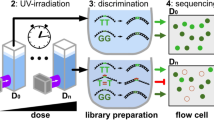Abstract
The frequency of UV-induced mutations at specific nucleotides along the lacI gene of Escherichia coli varies by as much as 80-fold1. The spectrum of mutations to amber, ochre, and UGA chain-terminating codons includes five hotspots accounting for over 30% of these UV-induced nonsense mutations1. The simplest explanation for the hotspot phenomenon is that the mutation frequency reflects the frequency of UV-induced DNA damage at the mutation site. To test this possibility, we measured the distribution, in a 380-base pair (bp) region of the lacI gene containing the nonsense mutation hotspots, of UV-induced cyclobutane pyrimidine dimers and pyrimidine–pyrimidine (6-4) photoproducts. The latter (also called the PydC lesion) is a UV-induced DNA lesion which occurs predominantly at TC and CC sequences2. The results reported here reveal the presence of UV-induced base damage hotspots which include the nonsense mutation hotspots. There is a linear relationship between base damage incidence and mutation incidence. The results suggest that the UV-induced pyrimidine–pyrimidine (6-4) lesion may be mutagenic.
Similar content being viewed by others
References
Coulondre, C. & Miller, J. H. J. molec. Biol. 117, 525–567 (1977).
Lippke, J. A., Gordon, L. K., Brash, D. E. & Haseltine, W. A. Proc. natn. Acad. Sci. U.S.A. 78, 3388–3392 (1981).
Haseltine, W. A., Lindan, C. P., D'Andrea, A. D. & Johnsrud, L. Meth. Enzym. 65, 235–248 (1980).
Haseltine, W. A. et al. Nature 285, 634–641 (1980).
Varghese, A. J. & Wang, S.-Y. Science 156, 955–957 (1967).
Wang, S.-Y. in Photochemistry and Photobiology of Nucleic Acids Vol. 1 (ed. Wang, S.-Y.) 295–356 (Academic, New York, 1976).
Drake, J. W. J. molec. Biol. 6, 268–283 (1963).
Howard, B. & Tessman, I. J. molec. Biol. 9, 372–375 (1964).
Osborn, M., Person, S., Phillips, S. & Funk, F. J. molec. Biol. 26, 437–447 (1967).
Brandenburger, A. et al. Nature 294, 180–182 (1981).
Kato, T., Shinoura, Y., Yemplin, A. & Clark, A. J. J. molec. gen. Genet. 180, 283–291 (1980).
Miller, J. H. & Schmeissner, U. J. molec. Biol. 131, 223–248 (1979).
Witkin, E. M. Science 152, 1345–1353 (1966).
Witkin, E. M. Bact. Rev. 40, 869–907 (1976).
Bridges, B. A. Mutat. Res. 3, 273–279 (1966).
Coulondre, C. & Miller, J. H. J. molec. Biol. 117, 577–606.
Gordon, L. K. & Haseltine, W. A. J. biol. Chem. 255, 12047–12050 (1980).
Author information
Authors and Affiliations
Rights and permissions
About this article
Cite this article
Brash, D., Haseltine, W. UV-induced mutation hotspots occur at DNA damage hotspots. Nature 298, 189–192 (1982). https://doi.org/10.1038/298189a0
Received:
Accepted:
Issue Date:
DOI: https://doi.org/10.1038/298189a0
- Springer Nature Limited
This article is cited by
-
Preparation of Photo-responsive DNA Supramolecular Hydrogels and Their Application as UV Radiometers
Chemical Research in Chinese Universities (2023)
-
Global genetic diversity, introgression, and evolutionary adaptation of indicine cattle revealed by whole genome sequencing
Nature Communications (2023)
-
Genome-wide mapping of genomic DNA damage: methods and implications
Cellular and Molecular Life Sciences (2021)
-
Exome sequencing identifies novel mutation signatures of UV radiation and trichostatin A in primary human keratinocytes
Scientific Reports (2020)
-
Solar-panel and parasol strategies shape the proteorhodopsin distribution pattern in marine Flavobacteriia
The ISME Journal (2018)





